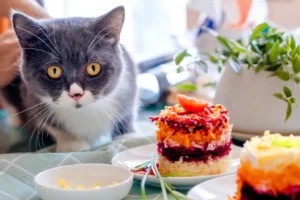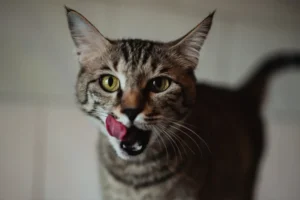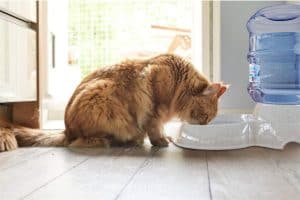Cats have a reputation for being finicky creatures, particularly when it comes to water. But why exactly are cats so weird about water? Let’s dive into the quirky behavior of our feline friends to uncover the reasons behind their aversion to getting wet.
Instinctual Behavior
Cats have a reputation for being weird about water, and it all boils down to their instinctual behavior. Picture this: back in the wild, their ancestors didn’t have someone to refill their water bowl. They had to rely on hunting for their hydration needs. So, the idea of voluntarily getting wet just doesn’t sit right with them. It’s like asking a fish to climb a tree – it’s just not in their nature.
In addition to this, cats are known for being meticulous groomers. They spend a good chunk of their day licking themselves clean. So, when they get wet, it messes with their meticulously crafted fur coat. It’s like having a bad hair day, but ten times worse for a cat.
And let’s not forget that cats are natural predators. Water can make them feel vulnerable and exposed, which goes against their instinct to always be on high alert. So, when your kitty gives you the stink eye for even daring to suggest a bath, just remember – it’s all in their DNA.
Sensitivity to Smells
Ah, the sensitivity to smells – another reason why our feline friends are so fussy about water. Cats have a keen sense of smell, and they can pick up on odors that we humans can’t even imagine. This means that the chemical scents in tap water, like chlorine, can be a real turn-off for them.
To put it in perspective, it’s like asking you to drink water that smells like a swimming pool – not very appealing, right? For cats, the smell of chemicals in water can trigger their instinct to stay away from anything that doesn’t smell like the fresh outdoors.
But fear not, there are ways to make water more palatable for your picky puss. Investing in a water fountain that filters out those pesky odors can make a world of difference. Plus, having a separate water bowl away from their food can also encourage them to stay hydrated without the scent interference. So next time your cat gives you the cold shoulder at bath time, at least you’ll understand where they’re coming from.
Grooming Habits
Cats are known for their meticulous grooming habits, spending a significant portion of their day cleaning themselves. Since they believe in their ability to keep themselves clean through grooming, water is often seen as unnecessary and disruptive to this routine. Cats have rough tongues covered in tiny hook-like structures called papillae, which they use to clean their fur by licking it. Water is not a part of their grooming process, so when they encounter it, they might feel uncomfortable or stressed as it goes against their natural instincts.
Evolutionary Reasons
Cats’ aversion to water can be traced back to their evolutionary origins in desert regions where water sources were scarce. Unlike their wild relatives like tigers, who are adept swimmers, domestic cats did not need to hunt underwater or swim to survive. Their ancestors learned to conserve water and stay dry to avoid dehydration in their arid habitats. This instinctual behavior has been passed down through generations, leading domestic cats to have a general dislike for water-related activities like bathing or swimming.
Unique Insight : Cats’ fur is naturally water-resistant due to the structure of their hair follicles, which helps them stay dry and maintain body temperature. This adaptation further reinforces their aversion to water, as they do not require regular baths like some other animal species do.
Temperature Preferences
Cats are known for being particular about their comfort, and water temperature is no exception. If the water is too cold or lukewarm, they may avoid it altogether. To entice your feline friend to enjoy water play, try using room-temperature water. This will be more appealing to them and increase the chances of them engaging in water activities. Remember, a little adjustment in temperature can make a big difference in their willingness to participate.
Playful Alternatives
Incorporating water play into your cat’s routine doesn’t have to be a challenge. Consider using interactive toys that involve water, such as water fountains or dripping faucets. These can pique your cat’s curiosity and encourage them to explore this element in a fun and engaging way. Another great idea is to introduce shallow water play sessions, like providing a bowl of water with floating toys for them to paw at. Making water play enjoyable and playful will help your cat overcome their natural aversion and potentially even learn to love it.
Fun Ways to Encourage Water Play:
- Use a cat water fountain to entice them with running water
- Try floating toys in a shallow bowl of water for interactive play
- Experiment with different water temperatures to find what they prefer
- Use water-safe cat toys to engage them in water play
- Slowly introduce your cat to water play in a positive and rewarding manner
By providing interactive and enjoyable water play experiences for your cat, you can help them overcome their aversion to water and possibly discover a new favorite activity.
Myth Busting
Let’s clear the air on a common misconception: not all cats hate water! While it’s true that many felines are a bit finicky when it comes to getting wet, some actually enjoy splashing around. So, if your kitty falls into the water-loving category, don’t be surprised – it’s perfectly normal behavior.
Encouraging Hydration
Keeping your cat hydrated can be a challenge, especially if they’re not big fans of drinking from a water bowl. One way to encourage hydration is to incorporate wet food into their diet. The high moisture content in wet food can help keep your cat’s water intake up. Additionally, consider investing in a cat fountain – the running water may entice your kitty to drink more. Remember, a well-hydrated cat is a healthy cat!
- Try Different Water Sources: Cats can be picky, so try offering water in different bowls, cups, or even a dripping faucet to see what your feline friend prefers.
- Flavor the Water: Adding a splash of tuna juice or chicken broth to your cat’s water can make it more appealing to them, encouraging them to drink more.
- Monitor Water Intake: Keep an eye on how much water your cat is drinking daily. If you notice a decrease in their water consumption, consult with your veterinarian to rule out any underlying health issues.
- Regularly Clean Water Bowls: Cats are known to be clean creatures, so make sure to clean their water bowls regularly to ensure the water is fresh and enticing.
- Consult a Vet: If you’re concerned about your cat’s hydration levels, don’t hesitate to seek advice from a veterinarian. They can provide tailored solutions to keep your furry friend hydrated and healthy.
Fun Facts
- Cats’ aversion to water dates back to their ancestors: Wildcats, the predecessors of domestic cats, lived in dry, desert-like habitats where water sources were scarce. This ingrained instinct may be why many cats today steer clear of water, though individual preferences can vary.
- Not all cats dislike water: While it’s a common stereotype that cats despise getting wet, some breeds actually enjoy water and even swimming. Maine Coons and Turkish Vans are known for their affinity for water, proving that not all felines follow the same script.
- Cats have unique grooming habits: Cats are meticulous groomers, using their rough tongues to clean themselves. Their self-cleaning behavior often makes them believe that they don’t need a water-based bath, as they can keep themselves clean without it.
- Water exposure can sometimes cause stress: For many cats, being submerged in water or even just being splashed can trigger feelings of vulnerability and fear. This reaction may stem from the fact that cats are natural hunters, and feeling wet can hamper their agility and camouflage abilities, making them uncomfortable.
- Cats’ unique dislike for walking on wet surfaces: Cats have sensitive paw pads, making walking on wet surfaces uncomfortable for them. This discomfort can amplify their aversion to water, as they try to avoid surfaces that feel strange or slippery.
Next time you see a cat darting away from a drop of water, remember these fun facts that shed light on their quirky relationship with water.
Alex, a passionate animal lover, has experience in training and understanding animal behavior. As a proud pet parent to two dogs and three cats, he founded AnimalReport.net to share insights from animal experts and expand his knowledge of the animal kingdom.









